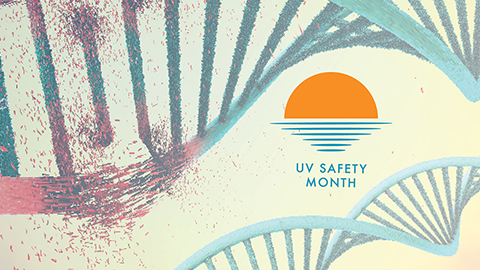UV Safety Month
UV Safety Month, headed up by the American Academy of Ophthalmology and observed by other health-focused organizations and agencies, usually manifests in public-education campaigns with two main thrusts: how to protect your eyes from the sun’s harmful rays and how to prevent skin cancer while still having summer fun.

Such information and advice are both helpful and necessary, and we certainly believe in UV-shielding sunglasses and sunscreen, among other protective measures. But we chose to participate in the observance for other reasons.
On any given day, ASBMB members and others who publish in our journals are both investigating the biological effects of ultraviolet light and using it as a tool in their research projects.
Below is a collection of recent papers (except for one very cool one we just had to include at the end) related to UV light and published in ASBMB journals. Many thanks to science communicator Jonathan Griffin for his skillful curation.
How eyeballs take out the trash
Debris from cells killed by UV radiation can accumulate in the eye, contributing to cataract formation. But, luckily, the eye lens has developed ways to clear this material. Researchers from Florida Atlantic University investigated exactly how eyes protect themselves from UV light and reported in the Journal of Biological Chemistry that lens epithelial cells phagocytize, or eat up, dead cell debris. It’s probably still a good idea to avoid looking at the sun, though, as the authors showed that too much UV light exposure damages proteins critical for phagocytosis.
Why sunlight and autoimmunity can be a bad mix
Exposure to UV radiation aggravates symptoms in patients with autoimmune disorders, such as lupus and dermatomyositis, but scientists have not been sure why. Researchers from the University of North Carolina showed that, in human skin cells, UV-induced DNA damage exacerbates the immune response to pathogenic stimuli presented by viral or microbial infections. The authors write in the Journal of Biological Chemistry that, although UV alone does not induce immune pathways, it may work together with infections to negatively affect patients with autoimmune disorders.
A new target for stifling skin cancer
Ultraviolet A light, or UVA, which comprises a specific range of wavelengths on the UV spectrum, makes up most of the UV in sunlight and is a major risk factor for skin cancer. However, exactly how UVA contributes to skin cancer has remained a mystery. Researchers in China and the United States recently uncovered that UVA promotes transcription of the protein p62, which upregulates expression of molecules that drive skin cancer development. The study, published in the Journal of Biological Chemistry, points to p62 as a potential target for skin cancer treatment.
Shining light on the effects of phototherapy
The combination of the light-sensitive drug psoralen and ultraviolet A light, or PUVA, is used to treat various skin diseases and prevent pathogen transmission during platelet transfusions. However, the biochemical effects of PUVA are not well understood. In a study published in Journal of Biological Chemistry, researchers in Belgium analyzed the effects of PUVA on signaling within platelets, revealing that the treatment prevents recruitment of certain kinases to the membrane, which could disrupt platelet function and increase bleeding risk.
Pining for UV-resistant trees
UV radiation has increased in recent years and is modeled to continue doing so in the coming decades. These changes could harm forests, which play important roles in the global ecosystem and supply material for timber products. To uncover how Pinus radiata, a fast-growing species of pine, may respond to the sunlight of the future, a team of researchers in Europe exposed trees to predicted doses of UV radiation. Their results in the journal Molecular & Cellular Proteomics reveal the identities of proteins associated with protective responses in pine, which could be useful information for breeding UV tolerant genotypes.
Disrupting nuclear machinery
The nucleolus is a structure within the nucleus that is known to carry out important tasks related to rRNA processing and ribosome assembly, but scientists have been uncertain how this organelle responds to UV radiation. Recently, an international team of researchers used imaging and proteomics to show that UV exposure altered nucleolar morphology and negatively affected proteins associated with DNA repair in human skin cells. Their results are published in the journal Molecular & Cellular Proteomics.
This fatty acid may keep skin young
Both the passing of time and UV radiation contribute to skin aging, but a team of South Korean researchers may have identified a way to slow the effects of each. In a study published in the Journal of Lipid Research, the omega 3 fatty acid eicosapentaenoic acid was topically applied to the skin of human subjects of varying age. The authors found that the fatty acid suppressed UV-induced enzymes that cleave collagen and also increased the expression of collagen forming proteins, reducing the effects of both age and radiation on human skin.
Enjoy reading ASBMB Today?
Become a member to receive the print edition four times a year and the digital edition monthly.
Learn moreGet the latest from ASBMB Today
Enter your email address, and we’ll send you a weekly email with recent articles, interviews and more.
Latest in Science
Science highlights or most popular articles

Defining a ‘crucial gatekeeper’ of lipid metabolism
George Carman receives the Herbert Tabor Research Award at the ASBMB Annual Meeting, March 7–10, just outside of Washington, D.C.

The science of staying strong
Muscles power every movement, but they also tell the story of aging itself. Scientists are uncovering how strength fades, why some species resist it and what lifestyle and molecular clues could help preserve muscle health for life.

Bacteriophage protein could make queso fresco safer
Researchers characterized the structure and function of PlyP100, a bacteriophage protein that shows promise as a food-safe antimicrobial for preventing Listeria monocytogenes growth in fresh cheeses.

Building the blueprint to block HIV
Wesley Sundquist will present his work on the HIV capsid and revolutionary drug, Lenacapavir, at the ASBMB Annual Meeting, March 7–10, in Maryland.

Gut microbes hijack cancer pathway in high-fat diets
Researchers at the Feinstein Institutes for Medical Research found that a high-fat diet increases ammonia-producing bacteria in the gut microbiome of mice, which in turn disrupts TGF-β signaling and promotes colorectal cancer.

Mapping fentanyl’s cellular footprint
Using a new imaging method, researchers at State University of New York at Buffalo traced fentanyl’s effects inside brain immune cells, revealing how the drug alters lipid droplets, pointing to new paths for addiction diagnostics.

